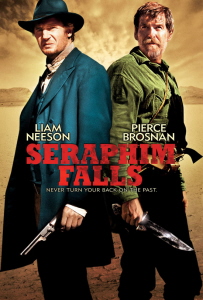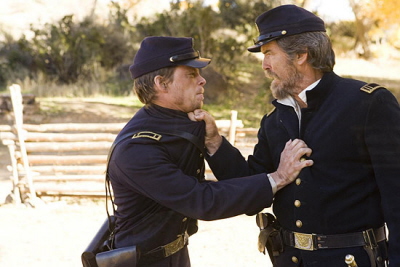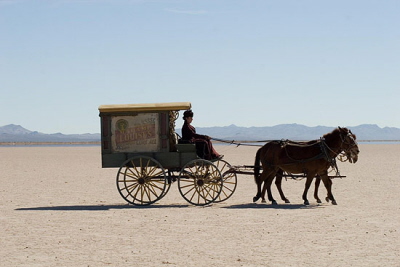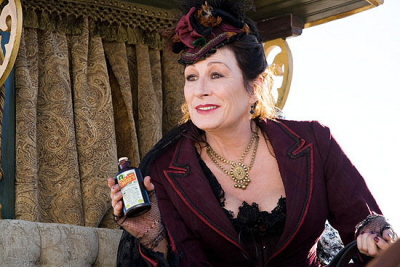 Seraphim Falls opens with Pierce Brosnan, swaddled in furs and high in the snowy mountains, making fire. Suddenly he’s shot in the shoulder and so begins a chase movie unlike any you’ve seen in quite some time. Brosnan, a former Yankee officer, is being chased by Liam Neeson, a former Confederate, down the mountains, over the plains and into the barren desert. Westerns are rarely made anymore, and when they do happen, they’re usually places where astonishing scenery is put on display – Seraphim Falls is a film like that, a movie where the landscape constantly vies to take your attention away from the main action
Seraphim Falls opens with Pierce Brosnan, swaddled in furs and high in the snowy mountains, making fire. Suddenly he’s shot in the shoulder and so begins a chase movie unlike any you’ve seen in quite some time. Brosnan, a former Yankee officer, is being chased by Liam Neeson, a former Confederate, down the mountains, over the plains and into the barren desert. Westerns are rarely made anymore, and when they do happen, they’re usually places where astonishing scenery is put on display – Seraphim Falls is a film like that, a movie where the landscape constantly vies to take your attention away from the main action
Director David Von Ancken is a first time feature helmer, but this isn’t his first time behind a camera. He’s directed shorts in the past, and his IMDB filmography is filled with well-known TV shows, but for Seraphim Falls he took the challenge of mounting a production in the outdoors, subverting our expectations and making a terrific modern entry in the Western genre. The film goes into limited release this Friday.
I had a chance to get on the phone with Von Ancken last week…
Landscapes are a major part of the film. When did that become an important part of the story for you?
I think it’s an important part of the story from the very first shot, and I always knew it would be the third main character of the movie. It’s what they inhabit, and it’s part of their hardship.
Where did you find these great locations?
We shot all over the state of New Mexico, from Taos to Santa Fe to Pueblo – up and down New Mexico. And we shot the water sequences in Oregon.
You’re up in the mountains in the snow, you’re out in the desert in the heat, and your actors are really out there in the conditions. How receptive were Liam Neeson and Pierce Brosnan to getting out there?
They knew from the beginning, because they read the script, what the deal was, and they were extremely cooperative and made it work.

Obviously they’re traveling through these landscapes, but they’re also traveling through Western movie archetypes. At the end, when they get to the desert, it reminded me of El Topo.
There are a number of archetypes that they go through, but it’s really a simple sort of quiet movie that we were trying to go for. It’s placing these complex characters in a simple, quiet landscape that would let them be, and let us tell the story from behavior from the beginning.
You open the film and there’s almost no dialogue – it’s a bold way to open the movie. Was there a concern about opening the movie in that way?
No. I’m coming from LA, where people need to have dialogue for everything, and they definitely don’t want you to make a Western, because nobody goes to see them. But this is something that transcends the old fashioned Western and goes for something contemporary. Pierce doesn’t say his first word for 26 of 27 minutes, and when you take an actor known for his way with dialogue and put him in a movie where he’s by himself… I guess you saw that in Cast Away, but you don’t see that much. You see it in those early Clint movies, those Sergio Leone movies, where you have moments of quiet.
What were some of the Westerns that influenced you?
When Sergio Leone was working with Clint. Once Upon a Time in the West. Some of Clint’s early movies like High Plains Drifter, Outlaw Josey Wales. These are movies I watched in a drive-in in upstate New York as a kid. Even Jeremiah Johnson with Redford. They have a quietness to them and a moral center with these strong yet complicated characters who have to sort things out for themselves.

I’m imagining that, in Hollywood terms, this is a low budget picture.
It’s under 20 million.
Does your experience as a TV director help you get in there and get your days and get in on time and in the budget?
Certainly the number of shows I’ve shot in the last year were essential. But the funny part is that I thought I would have the luxury of more time now that I was doing a feature, but it turned out to be the opposite. We used only available light and shot outside with a cinematographer named John Toll, who is very gifted at shooting available light. But in doing so, you’re tying yourself to the setting sun. We had 47 days, and for 46 of those we had no cover, so when the sun sets, you’re done. We had to move even faster than TV, if you can imagine.
Doing your first feature with John Toll’s a pretty good way to start out. What’s it like working with a real master of his craft? Is it tough being the new guy and telling this Oscar winner what to do?
John’s a real professional. In his world, the director is the boss. It’s different from TV, where you had groupthink in a lot of things; here you had one person who was responsible for it all. He’s a no-nonsense guy, and he came to me and said he’d cut his rate. Even a guy as talented as John doesn’t get to shoot many Westerns, many outdoor films, and definitely not many films that rely on available light. Ever, really.

Why was it important for you to do a picture that was outdoors?
It wasn’t something I consciously went after. I had a story in my mind, and it wasn’t even necessarily set in the West. It was a simple, allegorical, anti-war themed story that we’re never going to beat the audience over the head with, but it’s there, and it’s there consciously. When you want to do something like that, and you sit and think, ‘Where am I going to set this?’, you really come to the Western quickly because it’s one of the places where you can avoid society easily. I didn’t want to go to the archetypes of the saloon and the wooden sidewalks like that – I wanted to let the John Ford-esque landscapes talk with the characters about what the movie means. I consciously stayed away from any elements of society. There’s one sequence in a railroad camp, but it’s the only time you see anything man-made.
You directed an episode of Day Break, a show that really resonated with some of my readers. And which got canceled by ABC. Were you surprised by that?
I thought Day Break was just a really great show, and I’m glad to hear that your readers felt the same way. It was shot beautifully, it was acted beautifully, it was written beautifully. It may have been just a little too complicated for weekly audiences to get in to. Was I shocked? I don’t know what to make of it when shows are hits or are not. I’ve worked on a number of the top 10 dramatic shows on TV now and in their first year you never know if they’ll be successful or not. But I thought Day Break had a real great look and feel to it, and the episode I shot will be in the box set.
So they’re releasing it on DVD?
They’re never going to air it, but Touchstone is going to release it as a box set. If your readers are real aficionados for how it’s supposed to look, the producers and the studio are going through the trouble to finish the episodes, even the ones that didn’t air.
And it’s the full story?
It definitively ends, all the questions are answered, and it comes to a conclusion. In a way it’s become like a miniseries, or a very long movie.
